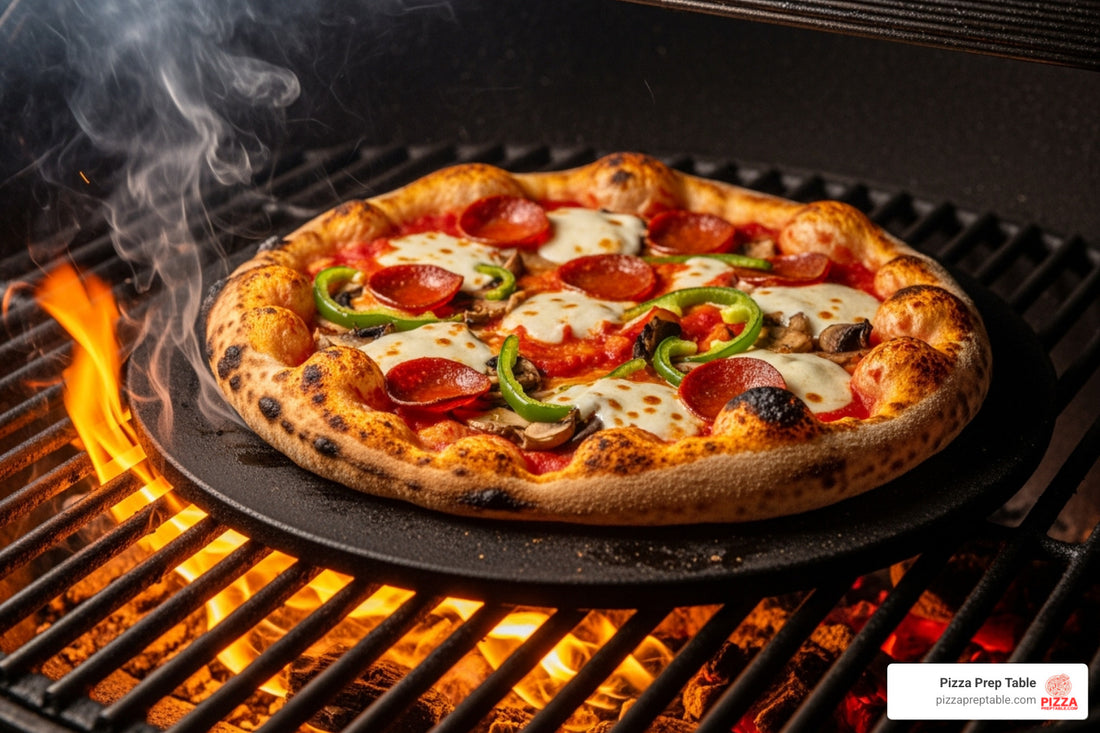
Cast Iron vs. Pizza Stone: The Grill-Off for Perfect Homemade Pizza
Share
Why Your Grill is Your Secret Weapon for Pizzeria-Quality Pizza
A pizza plate for grill transforms your backyard barbecue into a high-temperature pizza oven. Here's what you need to know:
Best Pizza Plates for Grilling:
- Cast Iron - Heavy-duty, versatile, great heat retention ($30-65)
- Pizza Stone - Classic choice, crispy crust, lighter weight ($35-60)
- Pizza Steel - Fastest cooking, superior heat transfer ($45-85)
- Pizza Screen - Budget-friendly, prevents soggy bottoms ($8-16)
Key Benefits:
- Achieves 500°F+ temperatures (vs. 450°F max in most home ovens)
- Creates authentic charred "leopard-spot" crusts
- Adds subtle smoky flavor
- Eliminates soggy bottoms through superior heat transfer
Grills generate intense, direct heat that home ovens can't match. While a kitchen oven tops out around 450°F, a preheated grill with a pizza plate easily reaches 600°F or higher. This extreme heat creates the rapid cooking and distinctive char that separates amateur pizza from the real deal.
One customer shared their experience: "I burnt about 4 pizzas before figuring out how to use the stone, but now my homemade pizzas cook in 5-6 minutes and taste better than delivery."
As Sean Kearney, I've spent years helping restaurant owners choose the right equipment. I've seen how the right pizza plate for grill can make the difference between mediocre and magnificent pizza. The best tools aren't always the most expensive—they're the ones that match your specific needs and cooking style.
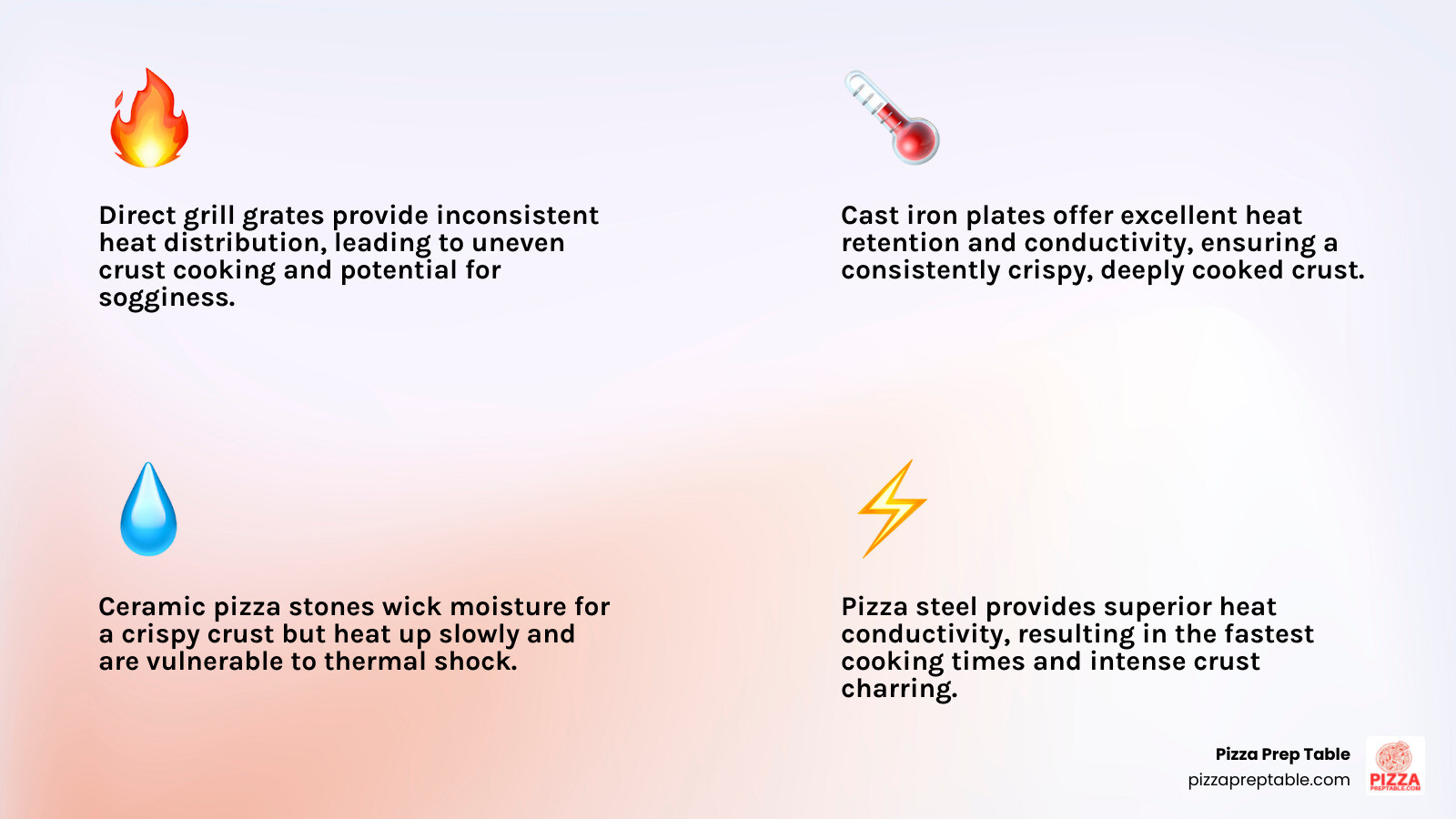
Choosing Your Ultimate Pizza Plate for Grill Domination
Choosing a pizza plate for grill is like picking the right tool for a job. Each material has unique strengths, shaping how heat moves through your dough to create everything from chewy to crispy crusts. The secret is understanding how different materials handle heat. Let's explore your options and find the perfect match for your grilling style.
| Feature | Cast Iron | Pizza Stone (Ceramic/Cordierite) | Pizza Steel | Pizza Screen / Perforated Pan |
|---|---|---|---|---|
| Heat Conductivity | Good | Fair | Excellent | Minimal (allows direct heat) |
| Heat Retention | Excellent (holds heat for multiple pizzas) | Good (can lose heat between pizzas) | Excellent (retains heat exceptionally well) | Low (designed for airflow) |
| Durability | Very High (virtually indestructible) | Moderate (prone to thermal shock/cracking) | Very High (practically indestructible) | Moderate (can warp or degrade nonstick) |
| Price Range | $30 - $65 | $35 - $60 | $45 - $85 | $5 - $17 |
| Best For | Crispy crust, versatile cooking | Classic Neapolitan-style, moisture wicking | Fastest cooks, ultimate char, high volume | Preventing soggy bottoms, thinner crusts |
Cast Iron: The Heavy-Duty All-Rounder
If you want a pizza plate for grill that's built like a tank, cast iron is your friend. It excels at heat distribution, soaking up heat evenly and holding it to create a consistently crispy crust.
The IKEA GRILLTIDER Pizza pan ($29.99) proves you don't need to break the bank. At 35 cm (13¾"), it's great for family dinners. For more robust options, the Pro-Logic Pizza/Roasting Pre-Seasoned Cast Iron Pan ($63.21) or the Lodge 10¼" Round Heavy-Duty Cast Iron ($31.49) offer legendary durability.
What makes cast iron special is its thermal mass; it keeps pumping out consistent heat even when a cold pizza is placed on it, ensuring an even cook. These pans are also incredibly versatile—the IKEA model doubles as a frying pan. One customer even uses their Lodge plate for tableside Korean barbecue!
The trade-off is weight; the IKEA pan is 8 lb 8 oz, so use reliable oven mitts. Cast iron also needs proper seasoning with oil and heat to perform at its best. The good news is that it gets better with use. If it ever starts sticking, a quick scrub with steel wool and re-seasoning brings it back to life.
Check out The Mighty Pizza Stone for more insights on durable pizza surfaces.
Pizza Stone (Ceramic/Cordierite): The Classic Choice
Pizza stones have been a go-to choice for decades. These ceramic or cordierite pizza plates for grill have a porous surface that pulls moisture from the dough, resulting in a perfectly crisp, airy crust.
The Weber Gourmet BBQ System Pizza Stone with its carry rack ($59.49) earns rave reviews (4.6 out of 5 stars). Users praise its quality, with one mentioning how their dough transformed like naan bread on the hot stone—a sign of excellent moisture absorption.
Budget-friendly options like the Unicook and Cast Elegance stones ($34.99 - $46.99) also deliver great results, creating a classic Neapolitan-style crust.
However, ceramic stones can be temperamental. They're prone to thermal shock—cracking from rapid temperature changes. This is a risk on a grill where temperatures swing dramatically. The key is to always preheat your stone with the grill, bringing it to temperature gradually.
For more guidance on managing different heat sources, check out our guide on Fueling the Fire: Choosing Between Char Broiler, Gas, and Charcoal. With proper care, even the most delicate stone will reward you with years of perfect pizza.
Pizza Steel: The Modern Powerhouse
Want to cook pizza so fast it'll make your head spin? Pizza steel is the modern answer for incredibly fast cooking. These thick steel plates conduct heat like lightning, transferring intense energy to the dough faster than any other material. This creates the coveted charred spots, or "leopard-spotting," that define professional-quality pizza.
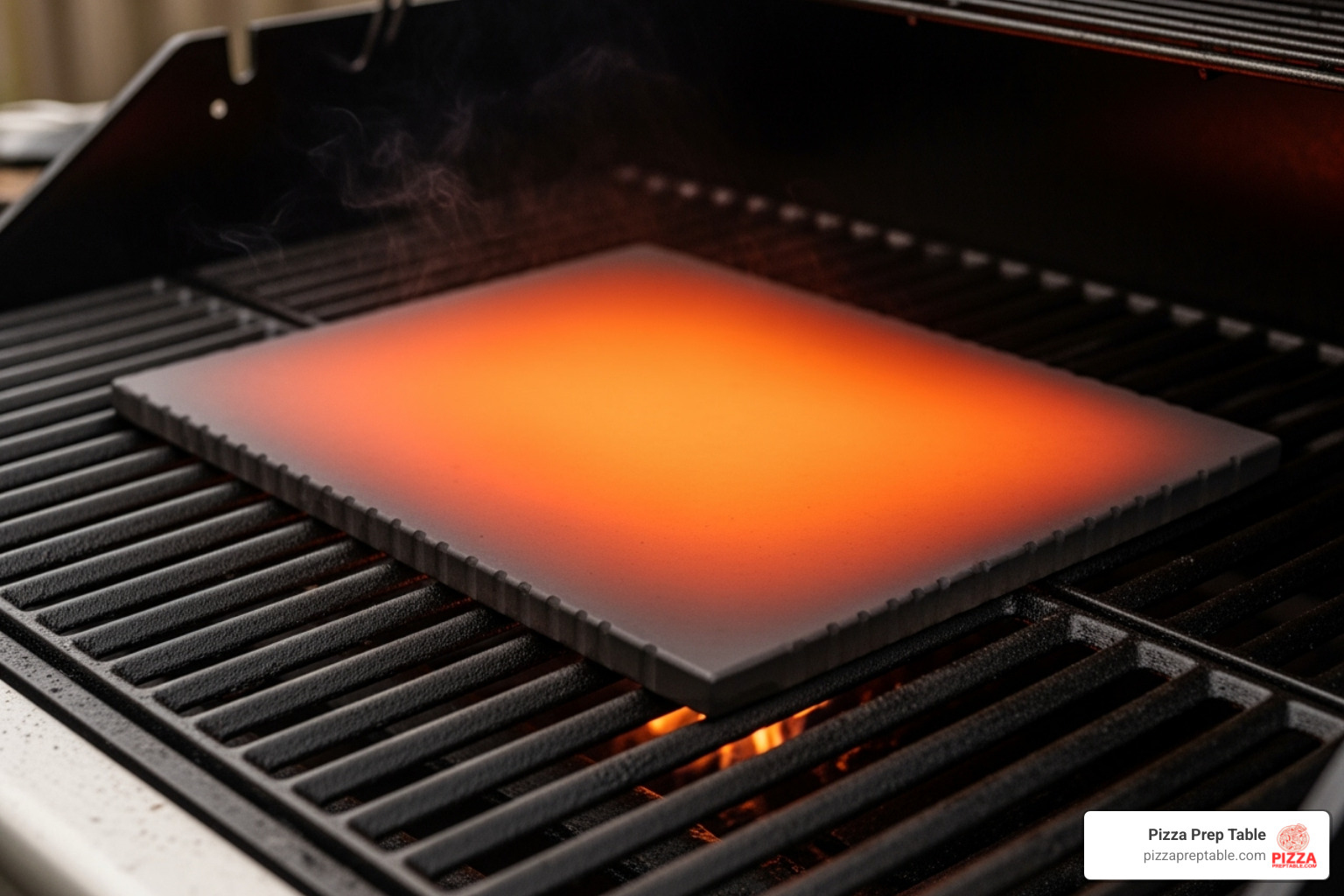
Pizza steel is virtually indestructible. Unlike ceramic stones, it isn't prone to thermal shock. The plates are heavy (around 15 pounds), but that mass is key to their effectiveness in holding and transferring heat.
With a preheated steel, pizzas can cook in just 4-6 minutes. This power has a learning curve, as the intense heat (750°F+) can burn the crust if you're not careful. Some users find it creates an amazing char on the bottom while leaving the top undercooked, so finding the right balance takes practice.
The higher price point ($45-85) reflects the quality and performance you're getting. For serious pizza enthusiasts who want the fastest cooking times and ultimate char, steel is unbeatable.
Pizza Screens & Perforated Pans: The Crispy, Budget-Friendly Option
Pizza screens and perforated pans are a simple, lightweight, and affordable way to get crispy crusts. The holes allow direct heat and smoke to reach the dough, preventing sogginess while promoting browning.
The Pizzacraft 13" Nonstick Pizza Screen ($15.99) is a customer favorite, while basic aluminum perforated pans start as low as $5.13. Pillsbury's nonstick pizza crispers come in under $11, proving that great pizza doesn't require a huge investment.
These screens are easy to handle and can withstand high temperatures (Pizzacraft up to 750°F), though indirect heat in the 350-450°F range is often recommended.
Screens don't retain heat like stone or steel, but they excel at preventing moisture buildup. They are great for thin crusts and reheating pizza. As the experts at PizzaHomeChef note, screens also eliminate the need for cornmeal.
How to Grill the Perfect Pizza: A Step-by-Step Guide
Now that you've chosen your pizza plate for grill, it's time to turn your backyard into a pizzeria. Grilling pizza requires more finesse than burgers, but once you nail the technique, you'll be hooked. Success lies in proper prep, assembly, and heat management. Let's walk through the steps to avoid common pitfalls.
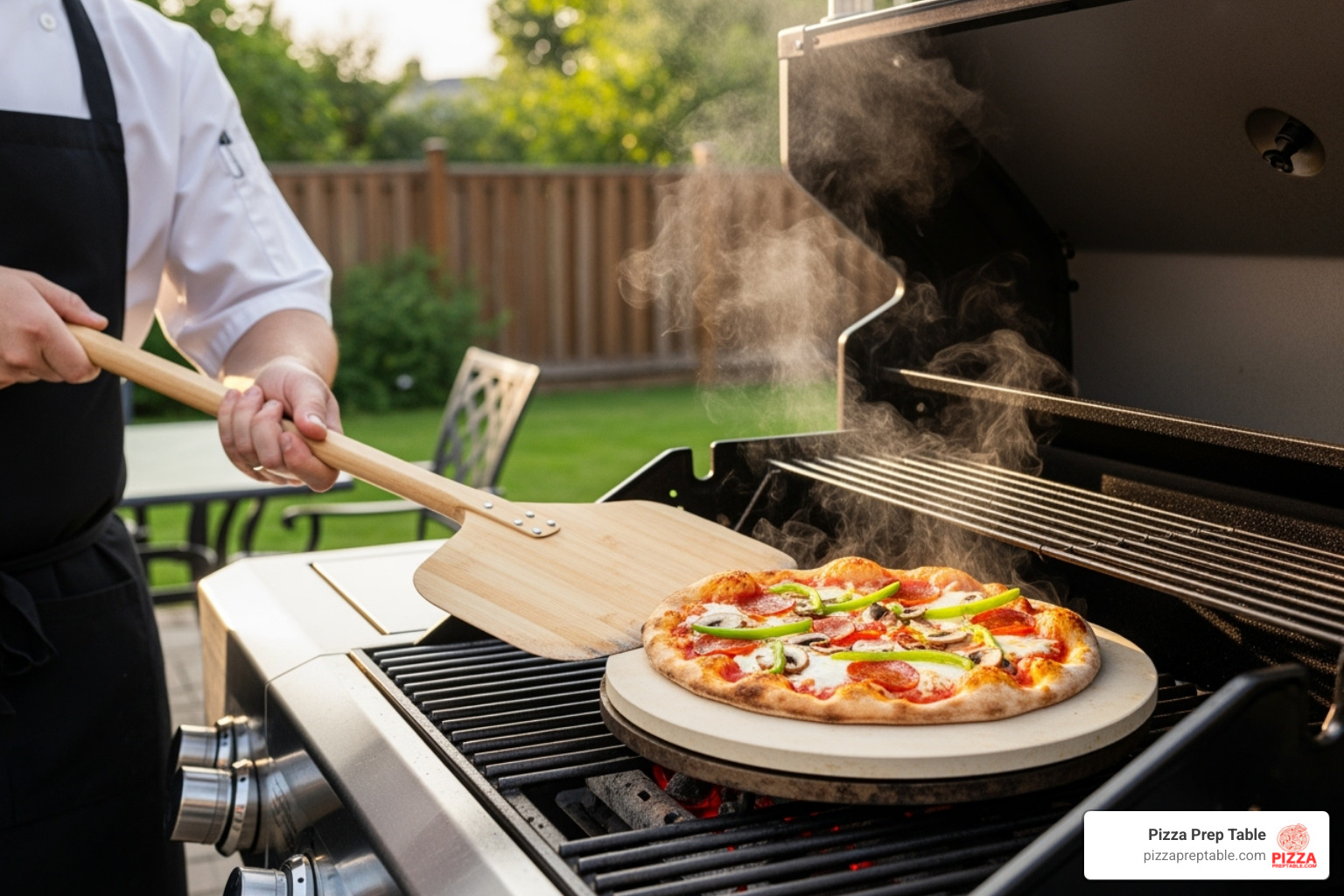
Step 1: Prep Your Grill and Pizza Plate for Grill Use
Your grill choice matters. Gas grills offer precise temperature control, perfect for beginners. Charcoal grills reach scorching temperatures and add a subtle smoky flavor. For deeper insights, check out Everything You Need to Know About Char Broilers.
Regardless of your grill type, setting up for indirect heat is crucial. Create a hot zone for your pizza plate for grill and a cooler zone. On a gas grill, light the outer burners on high and leave the center one off. For charcoal, pile coals to one side.
Preheating is everything. Place your pizza plate on the grill before lighting it, then let everything heat together for at least 30-45 minutes with the lid closed. You're charging the plate with thermal energy. Aim for 500°F or higher on your grill thermometer, but start conservatively until you learn your grill's behavior.
Step 2: Assemble and Launch Your Pizza
With your grill and pizza plate for grill hot, it's showtime. A pizza peel is your best friend for safely launching the pizza. Dust the peel generously with cornmeal or semolina flour; these act like tiny ball bearings, letting your pizza glide smoothly onto the hot surface.
Stretch your dough, don't roll it, to avoid a dense crust. Aim for even thickness. When it comes to toppings, less is more to prevent a soggy crust. Think pizza, not casserole.
For the perfect foundation, start with our tested homemade pizza dough recipe. Once assembled, the launch is everything. Position your peel at the back of the plate and give it a quick, confident jerk. Hesitation can lead to a folded mess.
Step 3: The Cook - Best Practices for Using a Pizza Plate for Grill Cooking
The moment your pizza hits the hot pizza plate for grill, close the lid immediately. This creates an oven-like environment where bottom heat cooks the crust and trapped hot air cooks the toppings.
Resist the urge to peek! Lifting the lid releases heat. Your first peek should be after 3-4 minutes to rotate the pizza 180 degrees for even cooking, as most grills have hot spots.
Stay vigilant—grilled pizzas cook fast, typically in 4-10 minutes. Pizza steel is fastest, while stones take longer. Check the bottom with your peel for a golden-brown color with some char.
Timing is everything. Pull the pizza when the crust is golden-brown and the cheese is bubbly. Overcooking turns crispy into cardboard.
A pro tip: rest your finished pizza on a wire rack for a minute before slicing. This prevents the bottom from getting soggy from steam and makes a huge difference.
Troubleshooting Common Grilled Pizza Problems
Even with the right gear, grilling pizza can be challenging. Here’s how to solve the most common issues for a perfect pie every time.
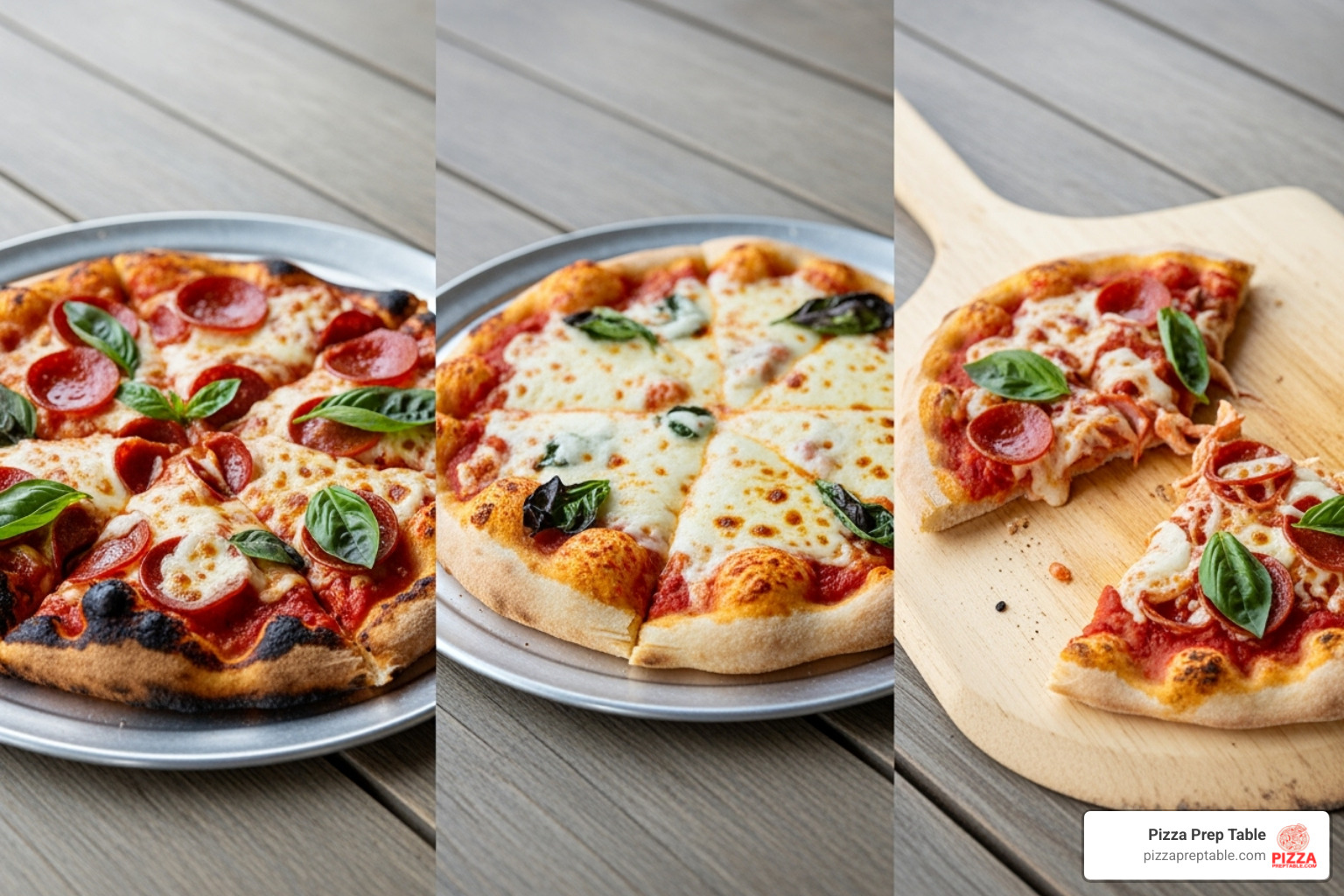
"My Crust is Burnt on the Bottom but the Toppings are Raw!"
This frustrating problem happens when your pizza plate for grill is too hot compared to the air inside the grill, creating a heat imbalance.
The quickest fix is lowering the direct heat under your plate. On a gas grill, turn down the burner beneath it. For charcoal, spread the coals out more.
Another trick is raising your plate higher from the heat source using heat-safe bricks or an inverted baking rack. This creates more distance from the intense heat.
If the bottom is done but the toppings are raw, finish it under your oven's broiler for 1-2 minutes to save the pizza. Some grillers use a pizza screen on their stone or steel as a buffer.
"Help, I Have a Soggy Middle!"
A soggy center is fixable and usually happens from too much moisture or not enough heat transfer.
The biggest culprit is wet toppings. Pre-cook ingredients like mushrooms, onions, and sausage to remove excess water.
Less sauce is more. A thick layer of sauce will create a soggy mess on the grill; use a thin, even layer.
Ensure your pizza plate for grill is screaming hot before launch. A proper 30-45 minute preheat is not optional; otherwise, the dough will steam instead of crisp.
Don't pile on toppings, as this traps moisture. Keep it simple. Once done, move the pizza to a wire rack to let air circulate underneath. For more insights, check out this discussion on serving plates.
"My Pizza is Stuck to the Plate!"
A stuck pizza happens when there isn't a good barrier between your raw, wet dough and the hot surface.
Your first defense is generous amounts of cornmeal or semolina on your peel. It acts like tiny ball bearings, helping the pizza slide off.
Ensure your pizza plate for grill is hot enough. A hot surface "shocks" the dough, causing it to release quickly.
A beginner-friendly trick is to use parchment paper. Assemble the pizza on parchment, transfer it to the hot plate, and then slide the paper out after 3-5 minutes once the crust has set. This allows the bottom to brown directly on the plate.
If you're still struggling, consider a nonstick pizza screen as your pizza plate for grill. They are designed to prevent sticking and are great for beginners.
Frequently Asked Questions about Grill Pizza Plates
Let's tackle the most common questions about using a pizza plate for grill.
What's the difference between a pizza plate and a pizza stone?
The term "pizza plate for grill" is an umbrella term for any flat surface used to cook pizza on a grill, including cast iron, steel, ceramic stones, and screens. A pizza stone is a specific type of plate, usually made from porous ceramic or cordierite. Its key feature is absorbing moisture from the dough to create a crispy crust. Simply put: all pizza stones are pizza plates, but not all pizza plates are pizza stones.
Can I use my regular oven pizza stone on the grill?
Yes, you can use an oven pizza stone on a grill, but be careful. Grills are more intense than ovens, especially charcoal ones. The biggest risk is thermal shock—rapid temperature changes that can crack the stone.
The golden rule is to always start cold: place the stone on the grill before lighting it and let them heat up together. This prevents cracking. Never place a cold stone on a hot grill or a hot stone on a cold surface.
Even stones designed for grilling, like the Weber Gourmet BBQ System, benefit from gentle temperature transitions. Treat your stone with respect, and it will reward you with years of perfect pizzas.
How do I clean a cast iron or ceramic pizza plate?
Proper care keeps your pizza plate for grill performing at its best. The cleaning method depends on the material.
For cast iron, once it's cool enough to handle but still warm, scrape off food bits with a metal spatula. Rinse with hot water, but skip the soap, as it strips the non-stick seasoning. Dry it immediately and thoroughly to prevent rust. To maintain the seasoning, rub a thin layer of cooking oil over the warm surface and wipe away the excess.
For ceramic pizza stones, let them cool completely to prevent cracking. Scrape off stuck-on bits and wipe with a damp cloth. Never use soap, as the porous stone will absorb it and affect the taste of your next pizza. Stains and dark spots are normal signs of a well-used stone and don't affect performance. Avoid soaking the stone in water.
Conclusion: Your Journey to Grilled Pizza Perfection
You now have the secret to turning your grill into a pizza-making powerhouse. Mastering grilled pizza is a rewarding journey, and the key difference between good and incredible pizza is often the right pizza plate for grill.
As we've explored, each material brings its own personality. Cast iron offers versatility and holds heat like a champ. Pizza stones provide a classic crispy texture by wicking moisture from the dough. Pizza steel delivers ultimate power with fast cooking times and professional-looking leopard spots. Even the humble pizza screen prevents soggy disasters.
There's no single "perfect" method. Your ideal setup depends on your grill, cooking style, and what excites you. Whether you prefer cast iron or a pizza stone, the beauty lies in experimentation.
Don't be discouraged by early attempts. Remember the customer who burned four pizzas before mastering their stone? Now they make restaurant-quality pies. Every mistake teaches you about heat management and timing.
The joy of creating that perfect pizza—with its crispy, charred bottom and bubbly cheese—right in your own backyard is unbeatable. There's something magical about gathering friends and family around the grill for a slice that rivals their favorite pizzeria.
For those catching the pizza-making bug and dreaming bigger, PizzaPrepTable.com is here to help. We understand that passion for perfect pizza doesn't stop at backyard grilling. We offer the commercial equipment and supplies to help you build your dream pizzeria or the ultimate home pizza station.
Whether you're serving customers in New York City, Los Angeles, or anywhere in between, the right equipment makes all the difference. From commercial pizza prep tables to professional-grade ovens, we provide the tools that help passionate pizza makers create perfect pies, every single time.
Your grilled pizza journey starts with that first perfect pizza plate for grill—but who knows where it might lead?
